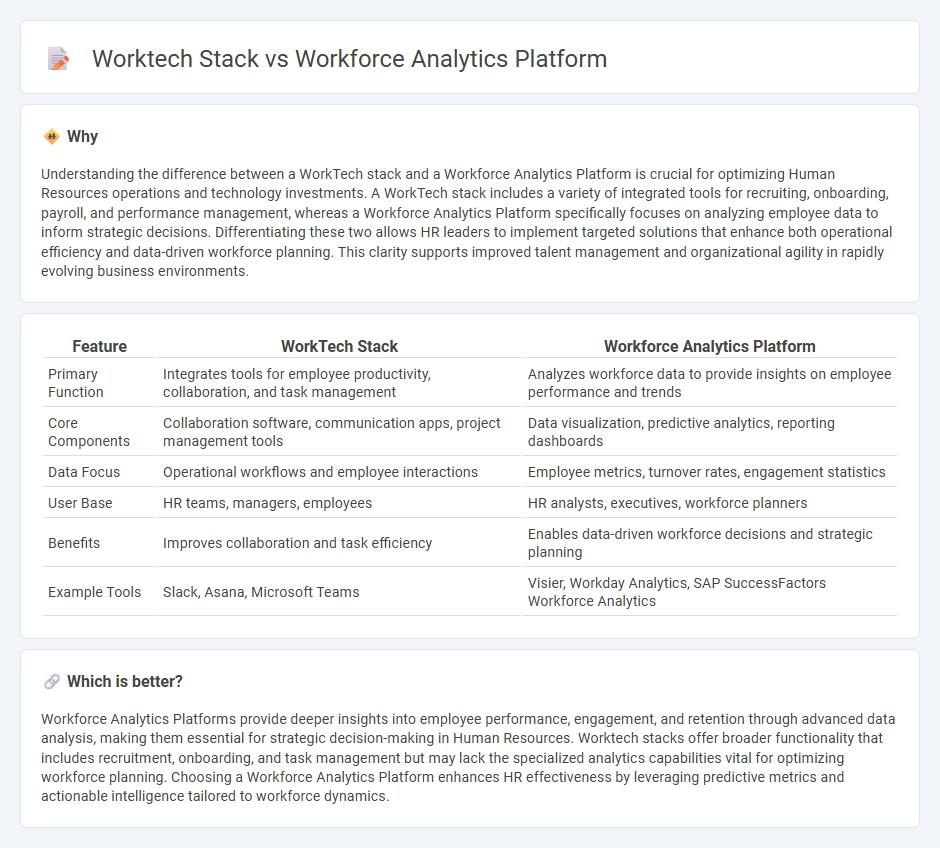
Worktech stacks integrate various digital tools to streamline HR processes such as recruiting, onboarding, and employee engagement, enhancing overall workplace efficiency. Workforce Analytics Platforms focus on collecting and analyzing employee data to provide actionable insights on performance, retention, and workforce planning. Explore deeper to understand how each solution can transform human resource management.
Why it is important
Understanding the difference between a WorkTech stack and a Workforce Analytics Platform is crucial for optimizing Human Resources operations and technology investments. A WorkTech stack includes a variety of integrated tools for recruiting, onboarding, payroll, and performance management, whereas a Workforce Analytics Platform specifically focuses on analyzing employee data to inform strategic decisions. Differentiating these two allows HR leaders to implement targeted solutions that enhance both operational efficiency and data-driven workforce planning. This clarity supports improved talent management and organizational agility in rapidly evolving business environments.
Comparison Table
| Feature | WorkTech Stack | Workforce Analytics Platform |
|---|---|---|
| Primary Function | Integrates tools for employee productivity, collaboration, and task management | Analyzes workforce data to provide insights on employee performance and trends |
| Core Components | Collaboration software, communication apps, project management tools | Data visualization, predictive analytics, reporting dashboards |
| Data Focus | Operational workflows and employee interactions | Employee metrics, turnover rates, engagement statistics |
| User Base | HR teams, managers, employees | HR analysts, executives, workforce planners |
| Benefits | Improves collaboration and task efficiency | Enables data-driven workforce decisions and strategic planning |
| Example Tools | Slack, Asana, Microsoft Teams | Visier, Workday Analytics, SAP SuccessFactors Workforce Analytics |
Which is better?
Workforce Analytics Platforms provide deeper insights into employee performance, engagement, and retention through advanced data analysis, making them essential for strategic decision-making in Human Resources. Worktech stacks offer broader functionality that includes recruitment, onboarding, and task management but may lack the specialized analytics capabilities vital for optimizing workforce planning. Choosing a Workforce Analytics Platform enhances HR effectiveness by leveraging predictive metrics and actionable intelligence tailored to workforce dynamics.
Connection
Worktech stacks integrate various digital tools to streamline HR processes such as recruitment, onboarding, and performance management, enabling seamless data flow. Workforce Analytics Platforms leverage this aggregated data to provide actionable insights on employee productivity, engagement, and retention trends. This interconnected ecosystem empowers HR teams to make data-driven decisions that optimize workforce planning and enhance organizational efficiency.
Key Terms
Workforce Analytics Platform:
A Workforce Analytics Platform leverages advanced data analytics, machine learning, and AI to provide actionable insights into employee performance, engagement, and retention, offering deeper strategic value compared to a traditional worktech stack's basic operational tools. This platform integrates diverse data sources such as HRIS, ATS, and performance management systems to deliver predictive analytics and workforce planning capabilities. Explore how implementing a Workforce Analytics Platform can transform decision-making and optimize your talent strategy.
Data Visualization
Workforce Analytics Platform excels in advanced data visualization by transforming complex HR metrics into intuitive dashboards and interactive charts, enabling data-driven decision-making across organizations. In contrast, a worktech stack offers a broader suite of tools, but often lacks the specialized visualization capabilities critical for uncovering workforce patterns and trends. Discover how leveraging sophisticated data visualization within workforce analytics can enhance strategic planning and operational efficiency.
Predictive Analytics
A Workforce Analytics Platform integrates advanced predictive analytics to forecast employee turnover, optimize talent acquisition, and enhance workforce planning by analyzing historical and real-time HR data. In contrast, a worktech stack encompasses a broader range of digital tools, including communication, collaboration, and productivity applications, but may lack the deep predictive capabilities found in specialized analytics platforms. Explore how predictive analytics within workforce analytics platforms can revolutionize your talent management strategies.
Source and External Links
Workforce Analytics and Insights - The ADP WorkForce Suite offers real-time labor data and predictive analytics to improve decision-making, optimize labor costs, and customize workforce reports tailored to your business needs.
Workforce Analytics Software - Teramind - Teramind provides workforce analytics with productivity monitoring, performance management, and predictive analytics to help businesses optimize employee performance and workforce planning.
10 Best Workforce Analytics Software in 2025 - Recruiters LineUp - Workforce analytics software integrates employee data from multiple systems, offers AI-driven predictive insights, and supports HR goals like turnover reduction, diversity tracking, and workforce planning to align HR initiatives with business outcomes.
 dowidth.com
dowidth.com